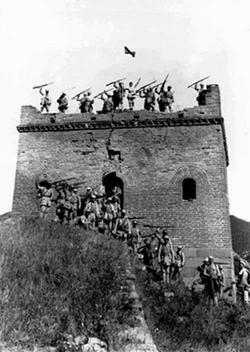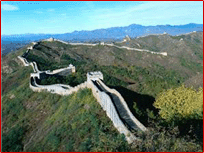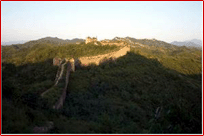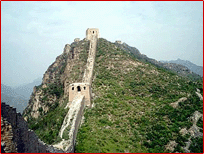 |
| Great Wall Hiking | China Adventure Tours | China City Tours | China Package Tours | Tibet Tours | Yangtze Cruise | Beijing Discount Hotels | About Us | Home |
|
 Gubeikou and Great Wall Hiking Tour to Gubeikou, the battlefield in the Chinese anti-Japanese War in 1933According to a Chinese saying, "You are not a man until you've walked the Great Wall." A tourist who visits Beijing without visiting the Great Wall is like traveling to Paris or Egypt without visiting the Eiffel Tower or the pyramids, respectively. After visiting ancient monuments, such as the Forbidden City and the Temple of Heaven in the city proper of Beijing, a tourist should experience the magnificence and steepness of the Great Wall, zigzagging along the hilltops of Beijing's suburbs. Starting from the Qin Dynasty (221-206 B.C.), there were over 20 states and feudal dynasties which participated in the construction of the Great Wall. It is said that the total original length of the Great Wall, after its completion, adds up to be over 50,000 kilometers. The sections of the Great Wall on the edge of Beijing proper were constructed during the Ming Dynasty (1368-1644A.D). It is 629 kilometers long and has 100 passes and 400 beacon towers. Serving as an important defense in the capital's protection, this section of the wall was built under rigorous supervision, and with strictly selected building materials. Therefore, it is undoubtedly the most magnificent, precipitous, and indestructible section of the Great Wall. About 600 kilometers of the Great Wall in the Beijing area are virtually untouched. In order to protect the rare historical relic, the municipal government of Beijing recently enacted the Law on the Protection of the Great Wall. Many non-governmental organizations, such as the International Friends of the Great Wall founded by William Lindesay from England, also take an active part in protecting the Great Wall. Their efforts enable this unparalleled wonder to maintain its magnificence. In the previous issues of China Pictorial Badaling and Huanghuacheng sections of the Great Wall located on the outskirts of western Beijing was introduced. Besides these two sections, there is in fact another well-preserved section of the Great Wall that was built during the Ming Dynasty, called the Gubeikou Great Wall.  Gubeikou Gubeikou, situated in Beijing's Miyun County, is 125 kilometers away from Beijing proper. It has long been a town of military significance and an important passage to the capital city. The Yanshan Range winds from east to west and is cut off at Gubeikou, forming a natural narrow pass here. To the west of the pass are the Chaohe River and the Wohu Mountain, and to the east is the Panlong Mountain. From ancient times, Gubeikou has served as a route of strategic importance, linking the southern and northern areas of the Yanshan Range. As early as 2,500 years ago, a fortification was built here and was constantly reinforced throughout the following dynasties. The main part of today's Gubeikou Wall was constructed under the supervision of Xu Da, a noted general in the Ming Dynasty. It runs for more than 20 kilometers and consists of four sections: Wohushan, Panlongshan, Jinshanling, and Simatai. It has 143 beacon towers, each positioned at an average interval of 156 meters. The nearest two are only 30 meters apart. The inside of these towers varies in design. While some have a flat ceiling, others either have an arched ceiling, a domed ceiling, or an octagonal, painted ceiling. Each tower has two floors, six archways, and ten arched doors, allowing garrisoned soldiers to advance and retreat freely. The towers are also different in size. The largest one can accommodate a garrison of 100 soldiers, and the smallest one a garrison of 10 soldiers. The towers often have one to six portholes. The Gubeikou Great Wall was built along the precipitous mountain ranges, rising and falling at various sections. Simatai, built on a cliff, is extremely steep. A famous Great Wall specialist said: "The Great Wall is the best of Chinese architecture, and Simatai is the best of the Great Wall." There are plenty of legends about the Gubeikou Wall, especially the Simatai section, as well as historical relics. At night, from the Beijing Watchtower, 986 meters above sea level, one can see the lights shimmering in downtown Beijing. West of this tower is the steeply situated Fairy Tower, that looks like a slim fairy standing between shrubs and wild flowers. Because of its unique architectural characteristics, the Gubeikou section is rare among other sections of the Great Wall that were built during the Ming Dynasty. Gubeikou was one of the important passes used to repel Japanese in early 1930's. Gubeikou Tour and Hiking We are organizing the transportation to send you to this beautiful section of the Great Wall on daily basis. Each departure can be formed by 2-person-group, 3-person-group or 4-person-group. 
|
| Great Wall Hiking | China City Tours | China Package Tours | Shanghai World Expo | Shanghai Tours | China Discount Hotels | China Adventure Tours | Sitemap | Home |
| Copyright 2021 Great Wall Adventure Club (Beijing), a North America Commerce International (NACI) company.® |




